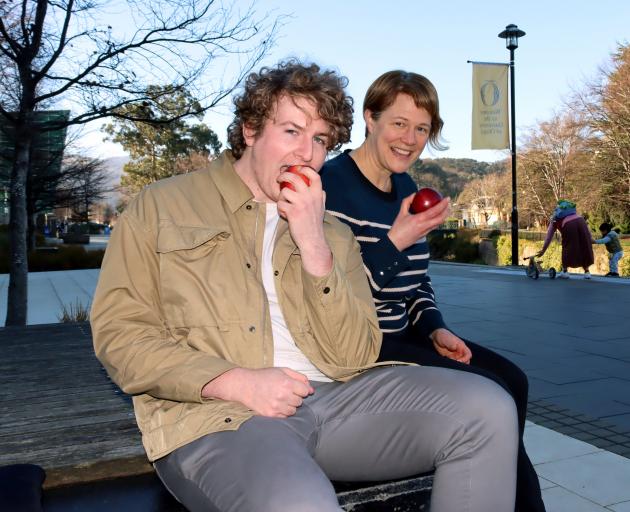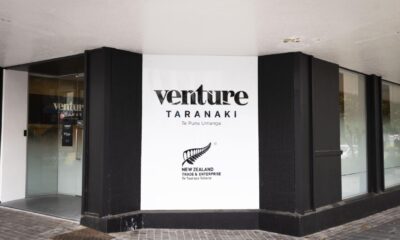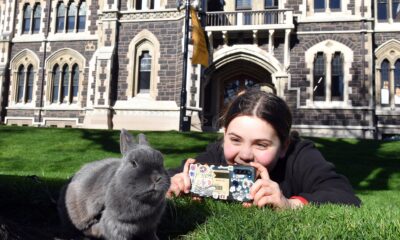Science
Scientist Maps Genetic Diversity in New Zealand’s Heritage Apples

Aaron Hewson, a master’s student in plant biotechnology at the University of Otago, is leading a significant research project examining over 300 apple varieties from the Jim Dunckley Heritage Orchard. Established 25 years ago by the Coastal Otago Branch of the New Zealand Tree Crops Association, this orchard is renowned for its extensive collection of apple cultivars, featuring unique varieties such as Peasgood Nonsuch, Nonnetit Bastard, Warner’s King, and Albany Beauty.
Hewson’s research aims to provide precise genetic identification of these heritage cultivars to aid in their preservation and propagation. “I am doing this research for them so they can continue to preserve and propagate the heritage cultivars, with confident identification by genetic means,” he stated. The original collection of apple varieties was gathered in the 1990s by Jim Dunckley from various locations across Otago and Southland, with a significant portion sourced from an old Plant & Food Research orchard in Clyde.
Hewson noted the eclectic nature of the collection, explaining that some trees bear names given by local farmers that reference nearby landmarks, which may not correspond to their genetic identities. “There is one case where we had a Plant & Food apple called Granny Smith, the classic one you get in supermarkets, and another one called Lord Lambourne. These two cultivars should be really different, but the samples were saying they were genetically the same,” he shared. This discrepancy indicates that one of the names may be incorrect.
To clarify these genetic identities, samples were collected by university students and staff from the Plant Biochemistry Lab. These samples were freeze-dried, labelled, and sent to a laboratory in France for genetic analysis, facilitated by Plant & Food Research, which is now part of the Bioeconomy Science Institute. “It has been very beneficial to have [Dr. Elena Lopez-Girona’s] expertise,” Hewson remarked, referring to his co-supervisor from Plant & Food Research.
The genetic analysis employs a method known as SNP chip technology, which tests approximately 50,000 known DNA hotspots in apple leaves. This process generates a genetic fingerprint that can determine whether two trees are the same variety or not. Hewson emphasized the importance of this local collection, noting that biosecurity regulations complicate the importation of new apple genetics. “If we talk about the entire amount of apples across the world, there are around 10,000 different varieties. But all of our commercial varieties, no matter how many there are, all come from just six apples, so it is really, really narrow,” he explained.
Associate Professor Lynnette Brownfield, another co-supervisor, highlighted the potential benefits of this research for apple breeding in New Zealand. Since the commercial apple varieties in the country stem from a limited genetic pool, identifying the unique genetics present in the orchard could lead to the discovery of new traits, including disease resistance.
The Coastal Otago Branch of the New Zealand Tree Crops Association will ultimately determine how the gathered genetic information is utilized. The goal is to assign unique identifiers to all the trees in the orchard, ensuring that the collection is fully documented. This comprehensive data will facilitate collaboration with apple breeders, ranging from backyard growers to larger organizations like Plant & Food Research, providing essential germplasm as needed.
Hewson’s work not only contributes to the preservation of New Zealand’s agricultural heritage but also aims to enhance the resilience and diversity of future apple cultivars. As the project progresses, the genetic insights gained may pave the way for innovations in apple breeding, ensuring that this rich legacy of heritage apples is sustained for future generations.
-

 Sports1 month ago
Sports1 month agoNetball New Zealand Stands Down Dame Noeline Taurua for Series
-

 Entertainment1 month ago
Entertainment1 month agoTributes Pour In for Lachlan Rofe, Reality Star, Dead at 47
-

 Sports1 month ago
Sports1 month agoSilver Ferns Legend Laura Langman Criticizes Team’s Attitude
-

 Entertainment1 week ago
Entertainment1 week agoNew ‘Maverick’ Chaser Joins Beat the Chasers Season Finale
-

 Entertainment2 months ago
Entertainment2 months agoKhloe Kardashian Embraces Innovative Stem Cell Therapy in Mexico
-

 Sports2 months ago
Sports2 months agoGaël Monfils Set to Defend ASB Classic Title in January 2026
-

 World3 months ago
World3 months agoPolice Arrest Multiple Individuals During Funeral for Zain Taikato-Fox
-

 Politics2 weeks ago
Politics2 weeks agoNetball NZ Calls for Respect Amid Dame Taurua’s Standoff
-

 Entertainment3 weeks ago
Entertainment3 weeks agoTyson Fury’s Daughter Venezuela Gets Engaged at Birthday Bash
-

 Sports3 weeks ago
Sports3 weeks agoHeather McMahan Steps Down as Ryder Cup Host After Controversy
-

 Entertainment3 weeks ago
Entertainment3 weeks agoTyson Fury’s Daughter Venezuela Gets Engaged at Birthday Bash
-

 World2 weeks ago
World2 weeks agoNew Zealand Firefighters Plan Strike on October 17 Over Pay Disputes



















